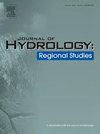Spatio-temporal dynamics of water quality and land use in the Lake Dianchi (China) system: A multi-source data-driven approach
IF 4.7
2区 地球科学
Q1 WATER RESOURCES
引用次数: 0
Abstract
Study region
Lake Dianchi, China.
Study focus
Urbanization and land development increasingly challenge water quality, yet their interactions remain unclear. This study examines these interactions in Lake Dianchi by developing an empirical water quality inversion model. Multi-year water quality data from monitoring stations were integrated with Landsat 8 L2 data to analyze seven key Water Quality Parameters (WQPs): TP, Hg, Cd, As, Zn, S, and NH₃-N. Land use was assessed using a multi-dimensional framework incorporating weighted overlays of multi-source data. The relationships between land use and water quality were analyzed using Spearman correlation, redundancy analysis (RDA), and the Optimal Parameter Geodetector (OPGD).
New hydrological insights for the region
From 2014–2022, pollutant concentrations declined, yet TP pollution remains severe, keeping the lake classified as Class V. Pollution was more concentrated in Caohai than Waihai, highlighting point-source pollution. Land use changes were dominated by “urban expansion” and the “returning farmland to forest” program. RDA results indicated that construction (positive) and farmland (negative) were the primary drivers of WPI. OPGD analysis showed that FACI∩CACI was the strongest explanatory factor for WPI. Over time, land use influence on WPI weakened due to urban saturation, environmental policies, and delayed water quality responses. These findings quantify land use-water quality interactions and provide insights for managing urban plateau lakes amid rapid development.
滇池系统水质与土地利用时空动态:多源数据驱动方法
研究区域:中国滇池。城市化和土地开发日益挑战水质,但它们之间的相互作用尚不清楚。本研究通过建立经验水质反演模型,对滇池的这些相互作用进行了研究。来自监测站的多年水质数据与Landsat 8 L2数据相结合,分析了7个关键水质参数(WQPs): TP、Hg、Cd、As、Zn、S和NH₃-N。土地利用评估使用多维框架,包括多源数据的加权叠加。利用Spearman相关、冗余分析(RDA)和最优参数地理探测器(OPGD)分析了土地利用与水质之间的关系。2014-2022年,污染物浓度有所下降,但总磷污染依然严重,保持在v类污染水平,草海比外海更集中,点源污染突出。土地利用变化主要为“城市扩张”和“退耕还林”。RDA结果表明,建设(正)和耕地(负)是WPI的主要驱动因素。OPGD分析表明,FACI∩CACI是WPI的最强解释因子。随着时间的推移,由于城市饱和、环境政策和延迟的水质响应,土地利用对WPI的影响减弱。这些发现量化了土地利用-水质相互作用,并为快速发展中的城市高原湖泊管理提供了见解。
本文章由计算机程序翻译,如有差异,请以英文原文为准。
求助全文
约1分钟内获得全文
求助全文
来源期刊

Journal of Hydrology-Regional Studies
Earth and Planetary Sciences-Earth and Planetary Sciences (miscellaneous)
CiteScore
6.70
自引率
8.50%
发文量
284
审稿时长
60 days
期刊介绍:
Journal of Hydrology: Regional Studies publishes original research papers enhancing the science of hydrology and aiming at region-specific problems, past and future conditions, analysis, review and solutions. The journal particularly welcomes research papers that deliver new insights into region-specific hydrological processes and responses to changing conditions, as well as contributions that incorporate interdisciplinarity and translational science.
 求助内容:
求助内容: 应助结果提醒方式:
应助结果提醒方式:


